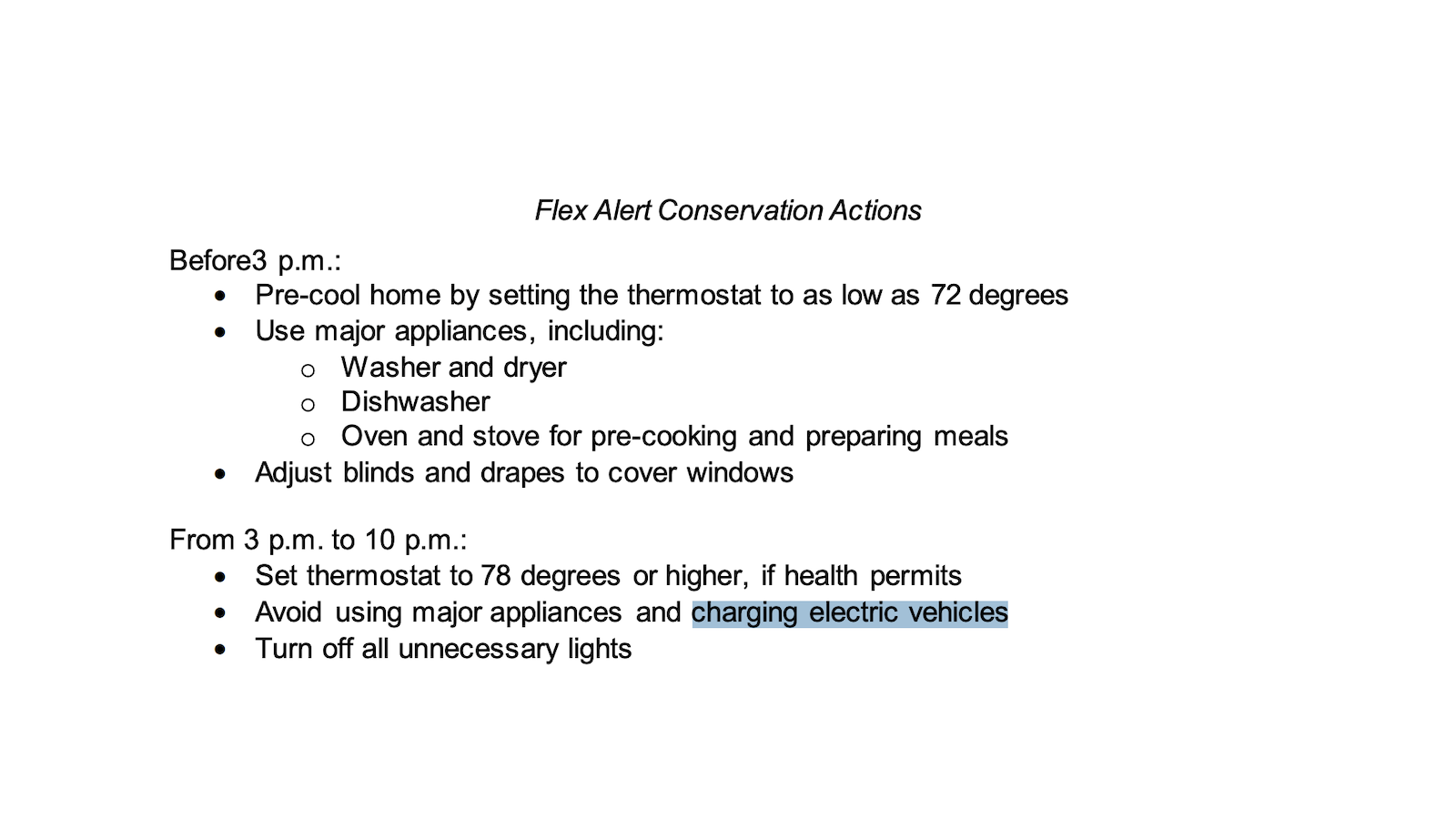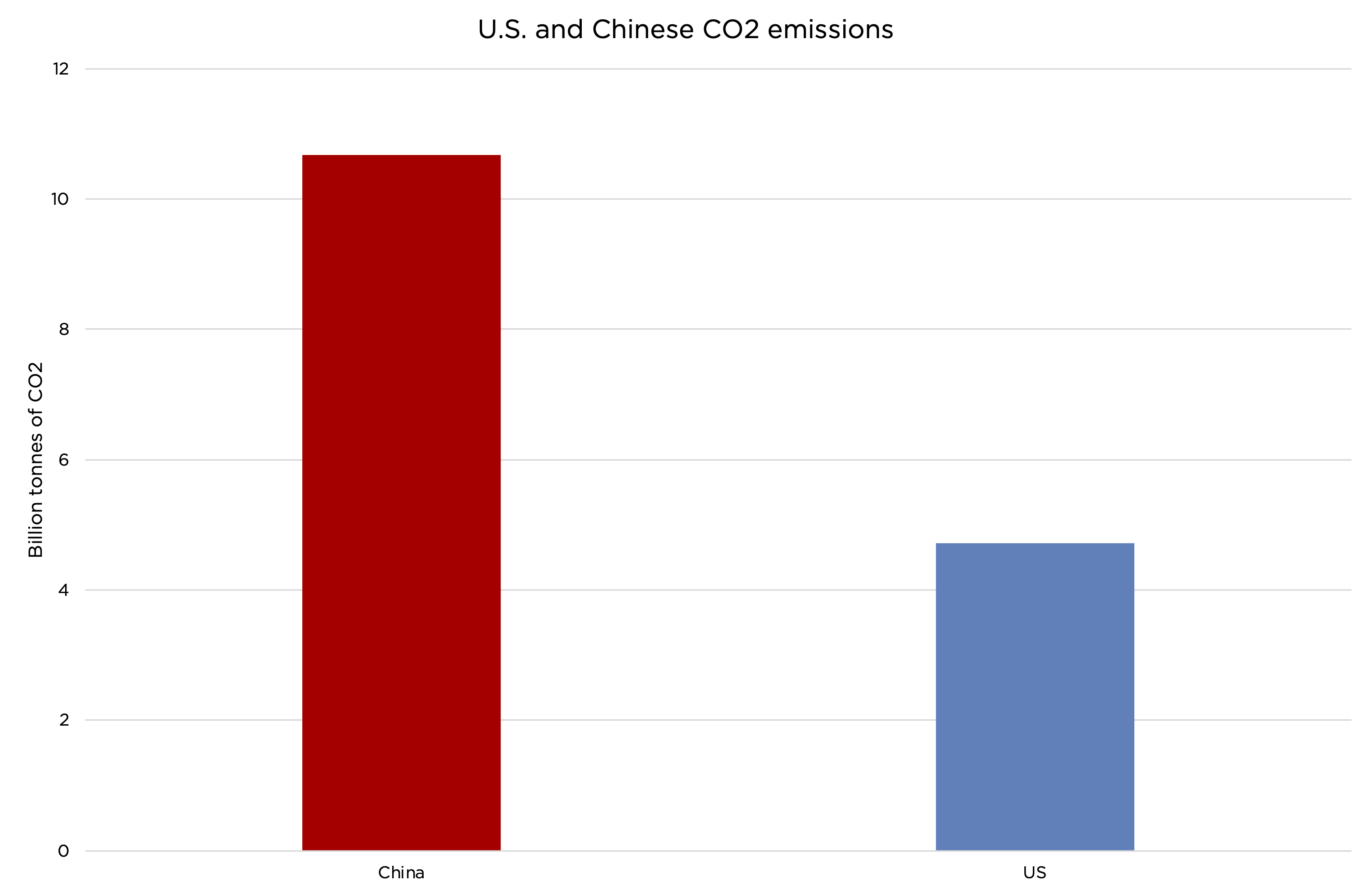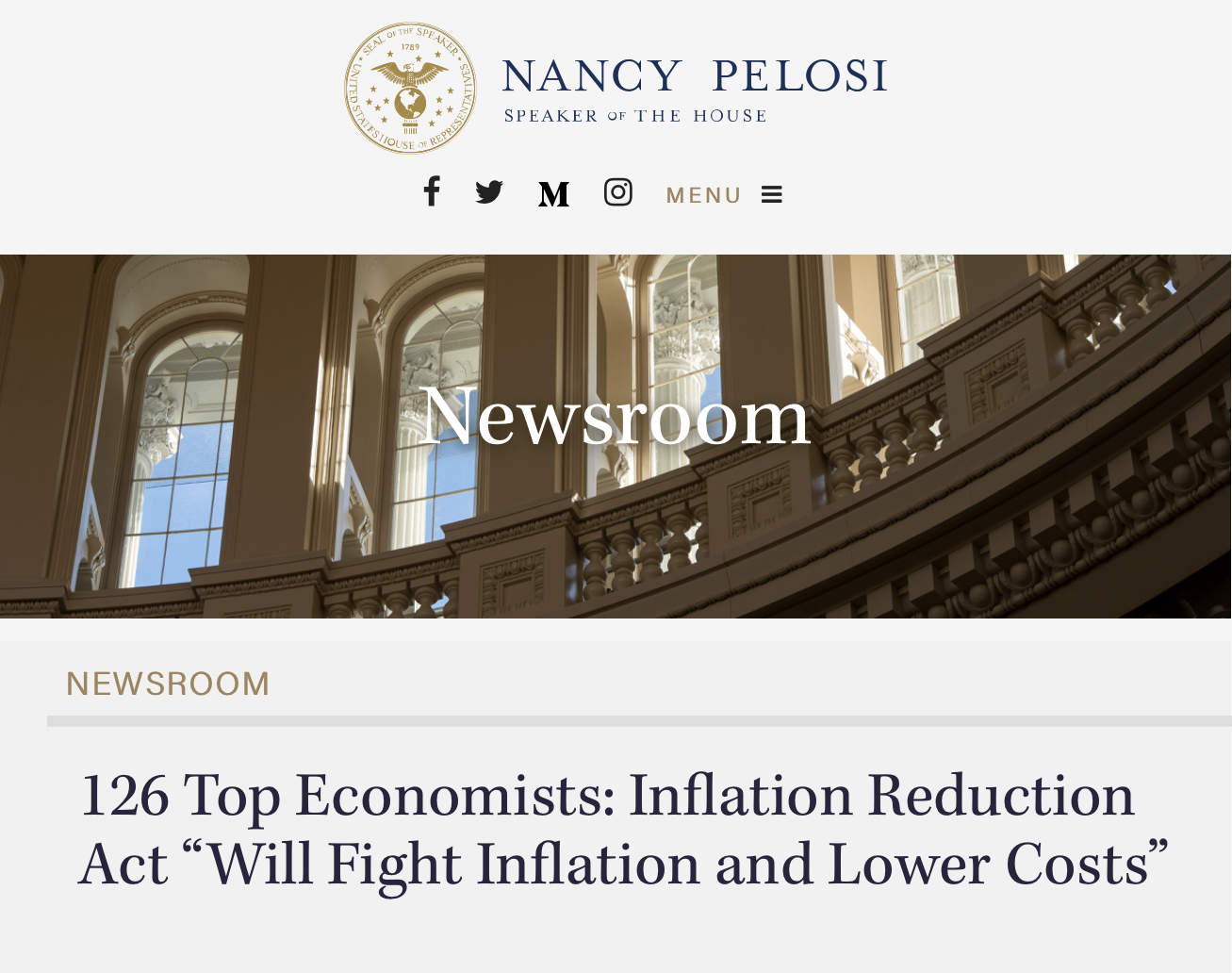Originally published on September 14, 2022
The Inflation Reduction Act is one of the worst energy policies in American history.
Its supporters are trying to hide this by spreading myth after myth about it being beneficial.
Here’s how to answer them.
-
Myth 1: The Inflation Reduction Act will lower the cost of energy.
Truth: The Inflation Reduction Act will rapidly raise the cost of energy via
- Policies that coerce us into using costly, unreliable “green” options
- Policies that increase fossil fuel costs
- More power for energy-obstructing bureaucrats and activists
-
The Inflation Reduction Act coerces grids and consumers into using costly, unreliable solar/wind electricity that they wouldn’t otherwise choose because it’s too expensive.
E.g., it indefinitely extends costly subsidies for unreliable solar/wind that defund and shut down reliable gas/coal plants.
-
At the same time the Inflation Reduction Act is promoting the shutdown of reliable electricity generation, it is—insanely—promoting far more use of electric cars via subsidies. California recently previewed the Inflation Reduction Act by telling citizens there wasn’t enough power for EVs even at 3% market penetration.1

-
The Inflation Reduction Act adds numerous taxes and restrictions on fossil fuels that will increase the cost of producing them. These include new or higher taxes on crude oil, on natural gas, on drilling on federal lands—all during an energy crisis where fossil fuels are desperately needed.2
-
Not only does the Inflation Reduction Act make energy more expensive by restricting fossil fuels directly, it does much more damage indirectly by giving much more money/power to anti-fossil-fuel bureaucrats and activists—who will eagerly restrict fossil fuel investment, production, and transport.
-
The Inflation Reduction Act gives anti-fossil-fuel bureaucrats/activists a new level of destructive power via language authorizing the Environmental Protection Agency to restrict any activity that emits CO2–which means anything the administration wants—under Section 115 of the Clean Air Act.3
-
The Inflation Reduction Act also gives anti-fossil-fuel bureaucrats/activists a new level of destructive power via $10s of billions for anti-fossil-fuel “environmental justice” causes. According to a WH-commissioned environmental justice report we must “sunset investment by 2030 in fossil fuels, plastics…and nuclear energy”!4
-
All claims that the Inflation Reduction Act will lower energy costs simply deny the obvious cost increases from:
- Policies that coerce us into using costly, unreliable “green” options
- Policies that increase fossil fuel costs
- More power for energy-obstructing bureaucrats and activists.
-
Myth 2: The Inflation Reduction Act does not harm fossil fuel production during an energy crisis.
Truth: The Inflation Reduction Act, via its new, cost-adding taxes on fossil fuels and especially via its authorization of the Environmental Protection Agency to take drastic action against fossil fuels, will absolutely harm our fossil fuel industry.
-
The bizarre claim that a law with new fossil fuel taxes and new Environmental Protection Agency anti-fossil-fuel powers doesn’t harm fossil fuel production is simply an attempt by politicians, most notably West Virginia’s Joe Manchin, to not alienate fossil fuel supporters. But FF supporters should be alienated.5
-
Myth 3: The Inflation Reduction Act is pro-nuclear.
Truth: The Inflation Reduction Act pretends to be pro-nuclear by including nuclear under “clean energy” subsidies. But since nuclear overregulation makes new plants cost-prohibitive, the Inflation Reduction Act’s endless “clean energy” subsidies are just an endless trough for solar/wind.
-
The Inflation Reduction Act won over many advocates of reliable electricity by including nuclear under the “Investment Tax Credit” and “Production Tax Credit” subsidies traditionally reserved for solar and wind. Many imagined that the Inflation Reduction Act would help usher in the nuclear renaissance that so many of us want. It won’t do this at all.
-
The key variable holding back nuclear is its near-criminalization by the government, which makes it nearly impossible to build new nuclear power plants. Since the advent of the Nuclear Regulatory Commission not one new plant has been approved from conception to completion.6
-
The Inflation Reduction Act does nothing to decriminalize nuclear. Instead, it adds nuclear to traditionally solar/wind subsidies. At best this will prevent some plants from shutting down—but that could be far better achieved by eliminating the solar/wind subsidies that drive nuclear closures.
-
In practice, almost all the Inflation Reduction Act’s “clean energy” subsidies will still go to solar/wind, not nuclear. But by nominally including nuclear, the Inflation Reduction Act got away scot-free with extending supposedly “temporary” subsidies indefinitely—until GHG emissions go down 75%, which means decades.
-
Myth 4: The Inflation Reduction Act won’t harm electricity reliability.
Truth: The IRA worsens 3 major factors already causing a reliability crisis. 1) Rewarding unreliable power 2) Prematurely shutting down coal plants 3) Forcing EV use on an already-inadequate grid
It’s a reliability nightmare.
-
Myth 5: The Inflation Reduction Act will create a dynamic, world-leading “clean energy” industry in America.
Truth: The IRA’s endless subsidies + controls favoring unreliable solar/wind will at best create an expensive, protectionist, parasitical industry that is anything but globally competitive.
-
World-leading industries come from freedom, including competition, not by bureaucrats dictating outcomes. Case in point: the world-leading US shale energy industry is a world-leading industry because free people were free to pursue the fuels and technologies they judged best.
-
Myth 6: The Inflation Reduction Act will onshore mining and manufacturing that are crucial for energy.
Truth: The Inflation Reduction Act doesn’t fix the reason we’re declining as a mining and manufacturing power: anti-development policies. In fact it increases such policies under the “environmental justice” banner.7
-
As long as anti-development industrial/environmental policies dominate the US, we will become a worse and worse place for heavy industries such as mining and manufacturing. By adding new subsidies and controls on top of anti-development policies the Inflation Reduction Act will make things worse.
-
Myth 7: The Inflation Reduction Act will increase US energy security.
The Inflation Reduction Act will decrease our energy security because it
- harms US oil and gas, which will be crucial indefinitely.
- creates a subsidized/controlled “green” pseudo-industry that will not overcome the China-controlled supply chain.
-
By harming US oil and gas through new taxes and especially through new powers for the Environmental Protection Agency to restrict oil and gas, the Inflation Reduction Act is emulating the now-obviously-insane policies of European countries who gutted their domestic fossil fuel production only to be at Russia’s mercy.
-
The Inflation Reduction Act’s alleged attempt at a domestic “green” industry involves keeping/worsening the anti-development policies that make us increasingly uncompetitive at mining and manufacturing, while imposing endless subsidies and controls favoring unreliable solar/wind. China isn’t scared.
-
China dominates the mining and processing of “renewable” materials to a staggering degree. We do little mining or processing of the needed materials, largely because of “green” restrictions the Inflation Reduction Act worsens. Our dependence on China for solar/wind dwarfs any oil/gas dependence.8
-
Not only does China dominate mining and processing of “renewable” materials, it dominates their manufacturing thanks to low-cost fossil fueled (especially coal) factories. By making electricity more expensive and less reliable the IRA makes us even less competitive in this space.
-
Myth 8: The Inflation Reduction Act will rapidly lower CO2 emissions.
Truth: CO2 emissions are a global issue; the only practical way of lowering them is developing globally cost-competitive low-carbon energy. The Inflation Reduction Act’s subsidies for non-competitive low-carbon energy will have little global effect.
-
An honest approach to CO2 emissions must recognize that they are a global issue—and they are rising because the world needs far more energy and CO2-emitting fossil fuels are usually the cheapest way to provide it. E.g., China and India are developing hundreds of new coal plants.9
-
The only practical and moral approach to lowering CO2 emissions is to bring about sources of energy that are globally cost-competitive—so that China, India, and everyone else will eagerly use them. The most promising way to do this is to liberate reliable, dense nuclear energy.
-
Instead of liberating nuclear or doing anything else to bring about globally-competitive alternatives, the IRA gives an endless trough of subsidies to “green energy” projects that can’t compete on their own. This punishes Americans but won’t affect global emissions.
-
China (> 30% of global emissions) already emits more than twice what the US (< 14%) and is on a growth trajectory, as Chinese are still far poorer than we are and emit far less per capita than we do. China will obviously not follow anything like the Inflation Reduction Act.10

-
The alleged reward we get for the Inflation Reduction Act’s endless, costly subsidies and for its costly new restrictions on fossil fuels, is, according to supporters, just a 10 percentage point decrease in US emissions. Globally that’s 1.4 percentage pts. In practice it’ll be lower due to offshored emissions.11

-
Myth 9: The Inflation Reduction Act will protect us from climate danger.
Truth: Even if the Inflation Reduction Act had a significant effect on global emissions, which it won’t, it would increase climate danger by making America poorer and thus far less resilient to all forms of climate danger—natural or manmade.
-
As illustrated by the last century, in which CO2 levels rose and climate-related disaster deaths plummeted, the main determinant of climate danger is not CO2 but our climate mastery ability. And climate mastery requires energy to power machines that heat, cool, irrigate, etc.12

-
The IRA harms American energy by coercing us to use costly, unreliable “green” energy and by restricting fossil fuel production. This will dramatically increase the cost of energy, which will lower our climate mastery ability, which will make us more vulnerable to climate danger.
-
For a mild preview of climate danger under the Inflation Reduction Act, see Europe—where citizens are increasingly afraid of summer and (especially) winter—not because of 1°C warming in the past 170 yrs but because many can’t afford air conditioning and heat. Just part of the hardship caused by “green” policies.
-
Myth 10: The Inflation Reduction Act will save us $1.9T in “social costs.”
Truth: This fiction comes from a “model” that
- ignores the huge costs of increased dependence on unreliable solar/wind and of new, onerous restrictions on fossil fuels.
- assumes fractions of a degree warming are catastrophic.
-
The White House’s celebrated “$1.9 trillion” number comes from a model assessment by the WH’s Office of Management and Budget (OMB) that ranges from “$0.7 and $1.9 trillion” in “climate-related benefits” over 3 decades. But this “model” does not at all model reality.13
-
It is clear that any policy that forces us to use costly “alternatives” and adds costs to fossil fuels will raise the cost of energy—and raising the cost of energy increases the cost of everything. Yet the White House model totally ignores these catastrophic costs.
-
The White House model also assumes fractions of a degree of warming will be catastrophic. E.g., that warming will be catastrophic for agriculture even though agriculture has thrived with warming so far—and can continue to thrive on a warmer planet with more CO2 using GMOs and other tech.
-
As we are now witnessing in Europe—where a lack-of-fossil-fuel crisis is causing mass hardship, deindustrialization, and fear of freezing this winter—lack of fossil fuels is incalculably deadly. That’s what the Inflation Reduction Act promises. And yet pro-Inflation-Reduction-Act “models” attribute no cost to this!
-
Myth 11: The Inflation Reduction Act is a victory against “special interests.”
Truth: The IRA prioritizes “green” special interests above all else. While it claims to be about rapid emissions reduction, it only hopes to reduce emissions by 10 percentage pts. Its real focus is enriching the green lobby.
-
If the Inflation Reduction Act sought rapid US emissions reduction, it would immediately and massively tax fossil fuel use. That would be terrible for our standard of living (which is why I’m against rapid emissions cuts) but it would be honest. The IRA instead dishonestly enriches green special interests.
-
It is hard to imagine a bill more full of special interest favoritism than the Inflation Reduction Act, which will pay up to 70% of the cost of wind turbines (the equivalent of paying $70K for a $100K EV) and 50%+ of the cost of “green hydrogen” that’s nowhere near competitive.14
-
The Inflation Reduction Act is one of the most corrupt laws in US history. It funnels billions of dollars into the pockets of solar, wind, EV, and other industries while punishing their competition. It also provides billions of dollars for Democrat political machinery disguised as “environmental justice” funding.15
-
Myth 12: The Inflation Reduction Act is a victory against “climate deniers.”
Truth: The IRA is a victory against “climate thinkers,” who know that modest CO2 reductions can’t be worth the devastation of 1) dependence on unreliable energy 2) making fossil fuel more expensive during an energy crisis.
-
Most IRA Act opponents don’t deny humans impact climate. What we “deny” is that any negative climate impacts of fossil fuels outweigh FFs’ massive, life-or-death benefits for billions.
And we certainly “deny” that wrecking US energy to lower US emissions solves anything globally.
-
Bonus Myth: The Inflation Reduction Act is good for our economy because 126 top economists said so.
Truth: Not only is it absurd of the White House to claim that a letter by less than 1% of economists means anything, but the letter they and many others cite makes no economic argument but rather vague assertions.16

-
None of the 126 economists the White House says we should bow to the authority of has addressed the argument that increased dependence on (China-controlled) unreliable solar/wind plus increased restriction of fossil fuels will drive up energy prices and therefore all prices.
-
Summary: Don’t believe the “Inflation Reduction Act” myths; the “IRA” is a 4-step recipe for destroying American energy
1 Make us more dependent on unreliable electricity
2 Impose new oil/gas taxes
3 Give Environmental Protection Agency more power to restrict fossil fuels
4 Give more power to anti-fossil-fuel activists
References
-
CAISO - California ISO issues Flex Alert for today, Sept. 8 California Energy Commission - Light-Duty Vehicle Population in California↩
-
API: Inflation Reduction Act Falls Short of Addressing U.S. Long-Term Energy Needs↩
-
National Law Review - U.S. Senate Passes the Inflation Reduction Act, Committing $370 Billion to Action on Climate and Energy↩
-
U.S. Environmental Protection Agency - White House Environmental Justice Advisory Council Final Recommendations Cover Letter May 21, 2021↩
-
Lovering et al. (2016) Power Hour - How to liberate nuclear energy, with Robert Zubrin↩
-
Reuters - Biden administration kills Antofagasta's Minnesota copper project
Mining.com - Biden administration moves to block Alaska Pebble mine
Reuters - Exclusive: Biden looks abroad for electric vehicle metals, in blow to U.S. miners↩ -
Alex Epstein - How the Biden Administration threatens energy security↩
-
As of July 2022, China and India have over 300 coal-fired power plants with a combined capacity of 221 GW planned or under construction. Global Energy Monitor - Global Coal Plant Tracker↩
-
Rhodium Group - A Turning Point for US Climate Progress: Assessing the Climate and Clean Energy Provisions in the Inflation Reduction Act↩
-
For every million people on earth, annual deaths from climate-related causes (extreme temperature, drought, flood, storms, wildfires) declined 98%--from an average of 247 per year during the 1920s to 2.5 in per year during the 2010s.
Data on disaster deaths come from EM-DAT, CRED / UCLouvain, Brussels, Belgium – www.emdat.be (D. Guha-Sapir).
Population estimates for the 1920s from the Maddison Database 2010 come from the Groningen Growth and Development Centre, Faculty of Economics and Business at University of Groningen. For years not shown, population is assumed to have grown at a steady rate.
Population estimates for the 2010s come from World Bank Data.↩
-
In addition to many questionable assumptions about speculative climate impacts, the Office of Management and Budget uses an extreme emissions scenario (RCP8.5) to inflate climate benefits.
Office of Management and Budget - CLIMATE RISK EXPOSURE: AN ASSESSMENT OF THE FEDERAL GOVERNMENT’S FINANCIAL RISKS TO CLIMATE CHANGE↩ -
The Production Tax Credit is worth up to $1.5 cents per kWh.
White & Case - Inflation Reduction Act Offers Significant Tax Incentives Targeting Energy Transition and RenewablesAssuming a low estimate of $6 per kg for unsubsidized hydrogen from zero-emission sources, the maximum subsidy for zero-emission hydrogen will be $3 per kg.↩
-
Hannah Perls - Breaking Down the Environmental Justice Provisions in the 2022 Inflation Reduction Act↩
